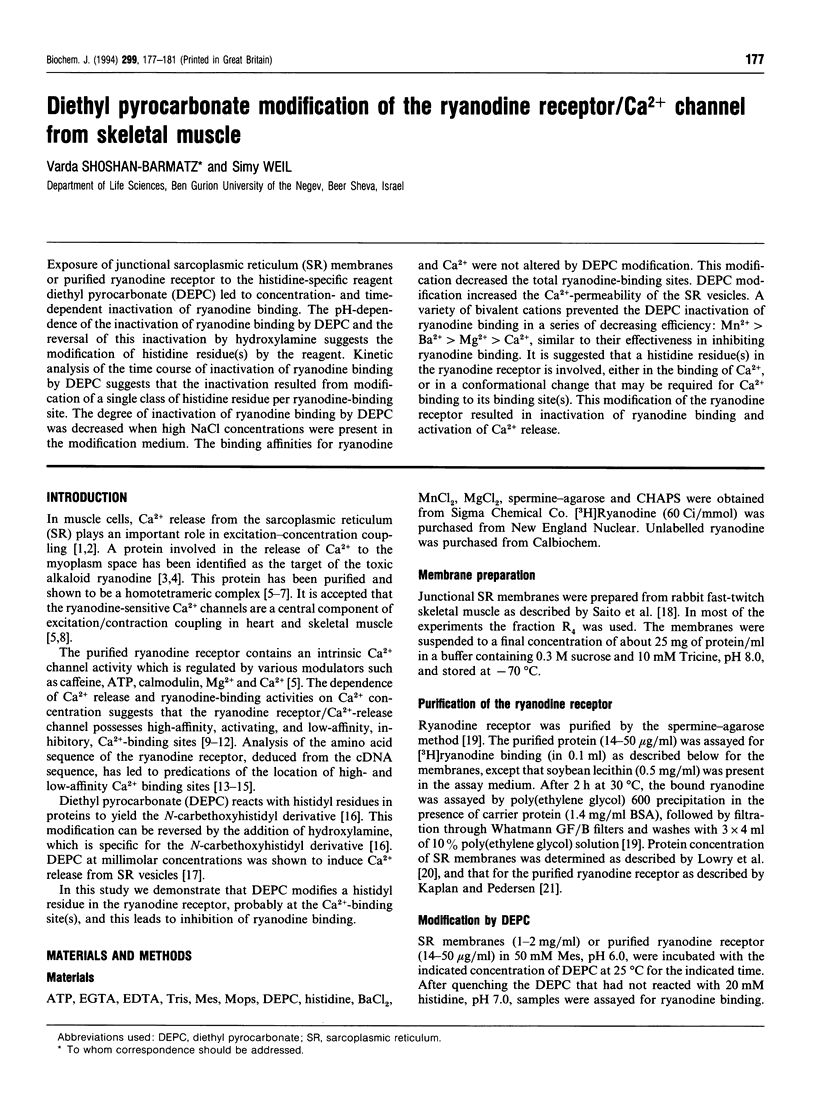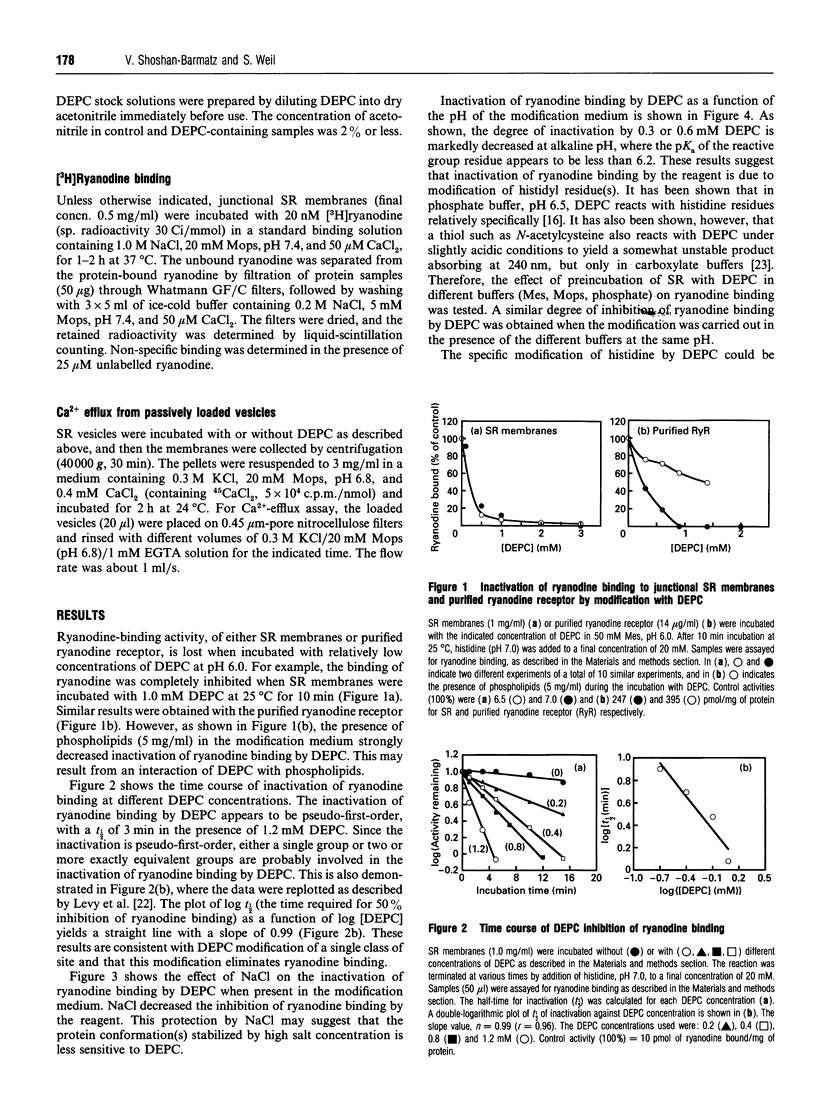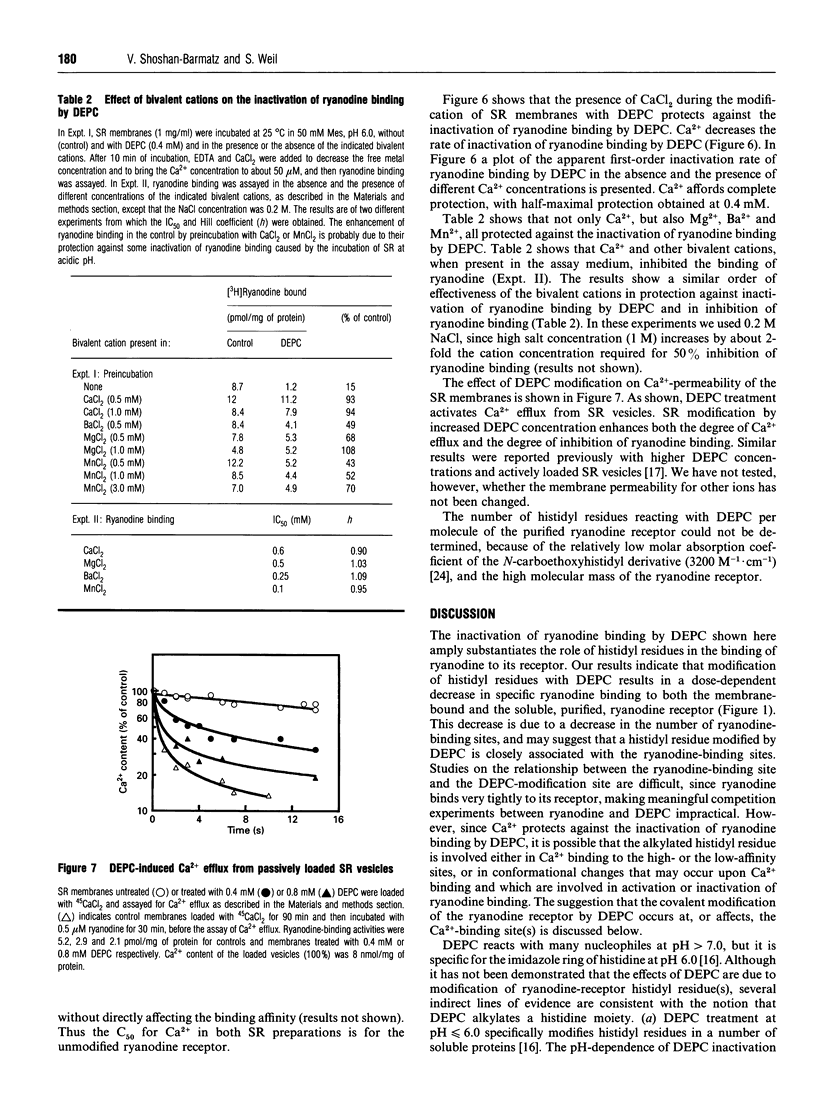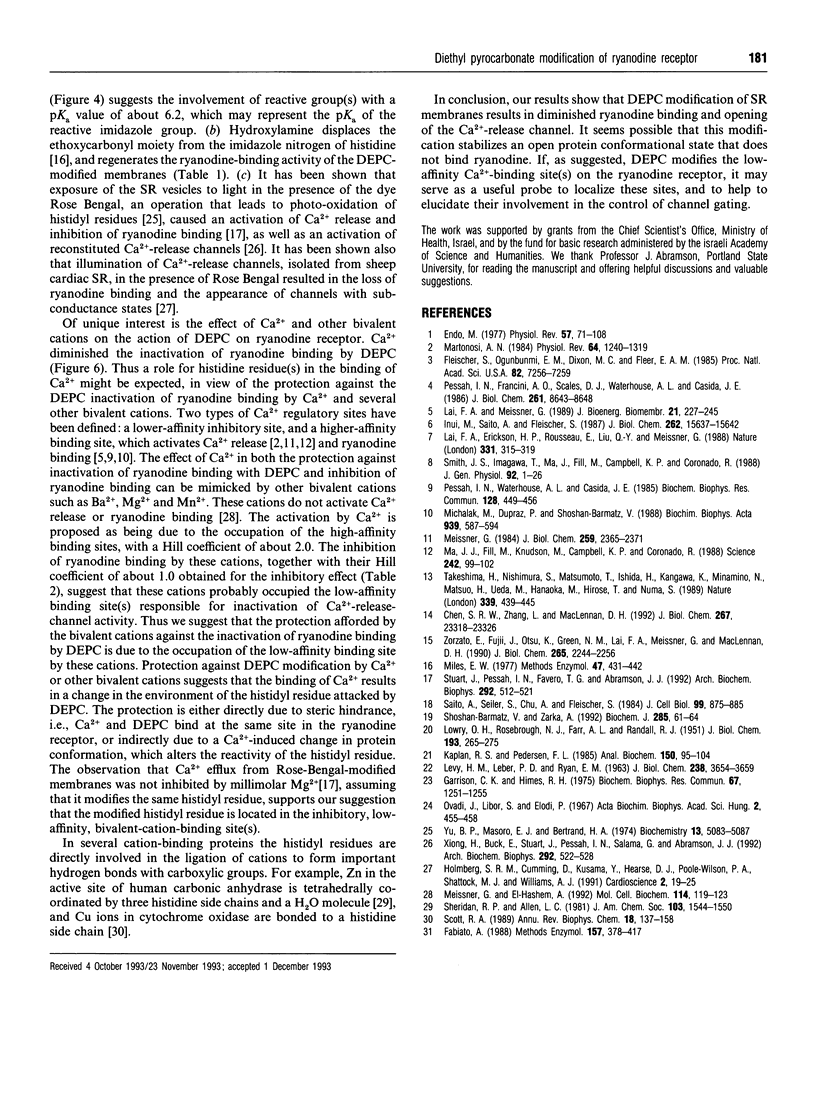Abstract
Exposure of junctional sarcoplasmic reticulum (SR) membranes or purified ryanodine receptor to the histidine-specific reagent diethyl pyrocarbonate (DEPC) led to concentration- and time-dependent inactivation of ryanodine binding. The pH-dependence of the inactivation of ryanodine binding by DEPC and the reversal of this inactivation by hydroxylamine suggests the modification of histidine residue(s) by the reagent. Kinetic analysis of the time course of inactivation of ryanodine binding by DEPC suggests that the inactivation resulted from modification of a single class of histidine residue per ryanodine-binding site. The degree of inactivation of ryanodine binding by DEPC was decreased when high NaCl concentrations were present in the modification medium. The binding affinities for ryanodine and Ca2+ were not altered by DEPC modification. This modification decreased the total ryanodine-binding sites. DEPC modification increased the Ca(2+)-permeability of the SR vesicles. A variety of bivalent cations prevented the DEPC inactivation of ryanodine binding in a series of decreasing efficiency: Mn2+ > Ba2+ > Mg2+ > Ca2+, similar to their effectiveness in inhibiting ryanodine binding. It is suggested that a histidine residue(s) in the ryanodine receptor is involved, either in the binding of Ca2+, or in a conformational change that may be required for Ca2+ binding to its binding site(s). This modification of the ryanodine receptor resulted in inactivation of ryanodine binding and activation of Ca2+ release.
Full text
PDF




Selected References
These references are in PubMed. This may not be the complete list of references from this article.
- Chen S. R., Zhang L., MacLennan D. H. Characterization of a Ca2+ binding and regulatory site in the Ca2+ release channel (ryanodine receptor) of rabbit skeletal muscle sarcoplasmic reticulum. J Biol Chem. 1992 Nov 15;267(32):23318–23326. [PubMed] [Google Scholar]
- Endo M. Calcium release from the sarcoplasmic reticulum. Physiol Rev. 1977 Jan;57(1):71–108. doi: 10.1152/physrev.1977.57.1.71. [DOI] [PubMed] [Google Scholar]
- Fabiato A. Computer programs for calculating total from specified free or free from specified total ionic concentrations in aqueous solutions containing multiple metals and ligands. Methods Enzymol. 1988;157:378–417. doi: 10.1016/0076-6879(88)57093-3. [DOI] [PubMed] [Google Scholar]
- Fleischer S., Ogunbunmi E. M., Dixon M. C., Fleer E. A. Localization of Ca2+ release channels with ryanodine in junctional terminal cisternae of sarcoplasmic reticulum of fast skeletal muscle. Proc Natl Acad Sci U S A. 1985 Nov;82(21):7256–7259. doi: 10.1073/pnas.82.21.7256. [DOI] [PMC free article] [PubMed] [Google Scholar]
- Garrison C. K., Himes R. H. The reaction between diethylpyrocarbonate and sulfhydryl groups in carbocylate buffers. Biochem Biophys Res Commun. 1975 Dec 1;67(3):1251–1255. doi: 10.1016/0006-291x(75)90807-4. [DOI] [PubMed] [Google Scholar]
- Holmberg S. R., Cumming D. V., Kusama Y., Hearse D. J., Poole-Wilson P. A., Shattock M. J., Williams A. J. Reactive oxygen species modify the structure and function of the cardiac sarcoplasmic reticulum calcium-release channel. Cardioscience. 1991 Mar;2(1):19–25. [PubMed] [Google Scholar]
- Inui M., Saito A., Fleischer S. Isolation of the ryanodine receptor from cardiac sarcoplasmic reticulum and identity with the feet structures. J Biol Chem. 1987 Nov 15;262(32):15637–15642. [PubMed] [Google Scholar]
- Kaplan R. S., Pedersen P. L. Determination of microgram quantities of protein in the presence of milligram levels of lipid with amido black 10B. Anal Biochem. 1985 Oct;150(1):97–104. doi: 10.1016/0003-2697(85)90445-2. [DOI] [PubMed] [Google Scholar]
- LEVY H. M., LEBER P. D., RYAN E. M. INACTIVATION OF MYOSIN BY 2,4-DINITROPHENOL AND PROTECTION BY ADENOSINE TRIPHOSPHATE AND OTHER PHOSPHATE COMPOUNDS. J Biol Chem. 1963 Nov;238:3654–3659. [PubMed] [Google Scholar]
- LOWRY O. H., ROSEBROUGH N. J., FARR A. L., RANDALL R. J. Protein measurement with the Folin phenol reagent. J Biol Chem. 1951 Nov;193(1):265–275. [PubMed] [Google Scholar]
- Lai F. A., Erickson H. P., Rousseau E., Liu Q. Y., Meissner G. Purification and reconstitution of the calcium release channel from skeletal muscle. Nature. 1988 Jan 28;331(6154):315–319. doi: 10.1038/331315a0. [DOI] [PubMed] [Google Scholar]
- Lai F. A., Meissner G. The muscle ryanodine receptor and its intrinsic Ca2+ channel activity. J Bioenerg Biomembr. 1989 Apr;21(2):227–246. doi: 10.1007/BF00812070. [DOI] [PubMed] [Google Scholar]
- Ma J., Fill M., Knudson C. M., Campbell K. P., Coronado R. Ryanodine receptor of skeletal muscle is a gap junction-type channel. Science. 1988 Oct 7;242(4875):99–102. doi: 10.1126/science.2459777. [DOI] [PubMed] [Google Scholar]
- Martonosi A. N. Mechanisms of Ca2+ release from sarcoplasmic reticulum of skeletal muscle. Physiol Rev. 1984 Oct;64(4):1240–1320. doi: 10.1152/physrev.1984.64.4.1240. [DOI] [PubMed] [Google Scholar]
- Meissner G. Adenine nucleotide stimulation of Ca2+-induced Ca2+ release in sarcoplasmic reticulum. J Biol Chem. 1984 Feb 25;259(4):2365–2374. [PubMed] [Google Scholar]
- Meissner G., el-Hashem A. Ryanodine as a functional probe of the skeletal muscle sarcoplasmic reticulum Ca2+ release channel. Mol Cell Biochem. 1992 Sep 8;114(1-2):119–123. doi: 10.1007/BF00240306. [DOI] [PubMed] [Google Scholar]
- Michalak M., Dupraz P., Shoshan-Barmatz V. Ryanodine binding to sarcoplasmic reticulum membrane; comparison between cardiac and skeletal muscle. Biochim Biophys Acta. 1988 Apr 22;939(3):587–594. doi: 10.1016/0005-2736(88)90106-x. [DOI] [PubMed] [Google Scholar]
- Miles E. W. Modification of histidyl residues in proteins by diethylpyrocarbonate. Methods Enzymol. 1977;47:431–442. doi: 10.1016/0076-6879(77)47043-5. [DOI] [PubMed] [Google Scholar]
- Pessah I. N., Francini A. O., Scales D. J., Waterhouse A. L., Casida J. E. Calcium-ryanodine receptor complex. Solubilization and partial characterization from skeletal muscle junctional sarcoplasmic reticulum vesicles. J Biol Chem. 1986 Jul 5;261(19):8643–8648. [PubMed] [Google Scholar]
- Pessah I. N., Waterhouse A. L., Casida J. E. The calcium-ryanodine receptor complex of skeletal and cardiac muscle. Biochem Biophys Res Commun. 1985 Apr 16;128(1):449–456. doi: 10.1016/0006-291x(85)91699-7. [DOI] [PubMed] [Google Scholar]
- Saito A., Seiler S., Chu A., Fleischer S. Preparation and morphology of sarcoplasmic reticulum terminal cisternae from rabbit skeletal muscle. J Cell Biol. 1984 Sep;99(3):875–885. doi: 10.1083/jcb.99.3.875. [DOI] [PMC free article] [PubMed] [Google Scholar]
- Scott R. A. X-ray absorption spectroscopic investigations of cytochrome c oxidase structure and function. Annu Rev Biophys Biophys Chem. 1989;18:137–158. doi: 10.1146/annurev.bb.18.060189.001033. [DOI] [PubMed] [Google Scholar]
- Shoshan-Barmatz V., Zarka A. A simple, fast, one-step method for the purification of the skeletal-muscle ryanodine receptor. Biochem J. 1992 Jul 1;285(Pt 1):61–64. doi: 10.1042/bj2850061. [DOI] [PMC free article] [PubMed] [Google Scholar]
- Smith J. S., Imagawa T., Ma J., Fill M., Campbell K. P., Coronado R. Purified ryanodine receptor from rabbit skeletal muscle is the calcium-release channel of sarcoplasmic reticulum. J Gen Physiol. 1988 Jul;92(1):1–26. doi: 10.1085/jgp.92.1.1. [DOI] [PMC free article] [PubMed] [Google Scholar]
- Stuart J., Pessah I. N., Favero T. G., Abramson J. J. Photooxidation of skeletal muscle sarcoplasmic reticulum induces rapid calcium release. Arch Biochem Biophys. 1992 Feb 1;292(2):512–521. doi: 10.1016/0003-9861(92)90024-q. [DOI] [PubMed] [Google Scholar]
- Takeshima H., Nishimura S., Matsumoto T., Ishida H., Kangawa K., Minamino N., Matsuo H., Ueda M., Hanaoka M., Hirose T. Primary structure and expression from complementary DNA of skeletal muscle ryanodine receptor. Nature. 1989 Jun 8;339(6224):439–445. doi: 10.1038/339439a0. [DOI] [PubMed] [Google Scholar]
- Xiong H., Buck E., Stuart J., Pessah I. N., Salama G., Abramson J. J. Rose bengal activates the Ca2+ release channel from skeletal muscle sarcoplasmic reticulum. Arch Biochem Biophys. 1992 Feb 1;292(2):522–528. doi: 10.1016/0003-9861(92)90025-r. [DOI] [PubMed] [Google Scholar]
- Yu B. P., Masoro E. J., Bertrand H. A. The functioning of histidine residues of sarcoplasmic reticulum in Ca2+ transport and related activities. Biochemistry. 1974 Dec 3;13(25):5083–5087. doi: 10.1021/bi00722a004. [DOI] [PubMed] [Google Scholar]
- Zorzato F., Fujii J., Otsu K., Phillips M., Green N. M., Lai F. A., Meissner G., MacLennan D. H. Molecular cloning of cDNA encoding human and rabbit forms of the Ca2+ release channel (ryanodine receptor) of skeletal muscle sarcoplasmic reticulum. J Biol Chem. 1990 Feb 5;265(4):2244–2256. [PubMed] [Google Scholar]


